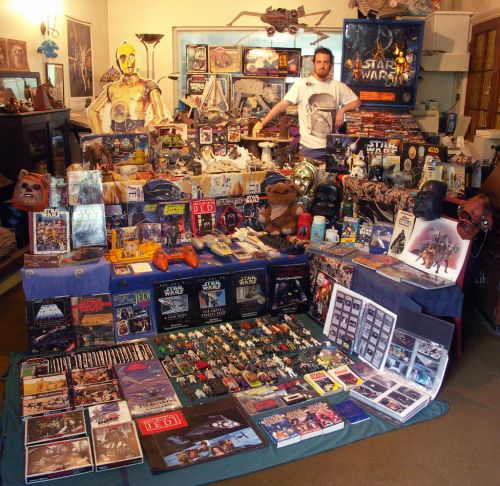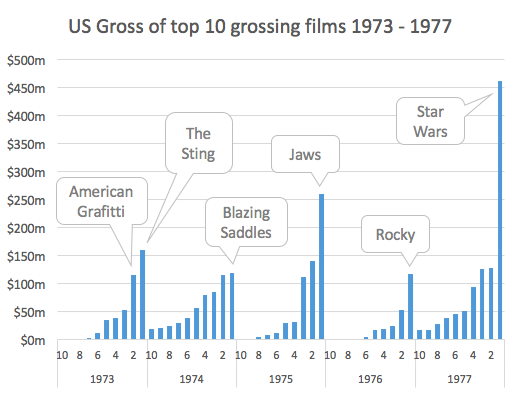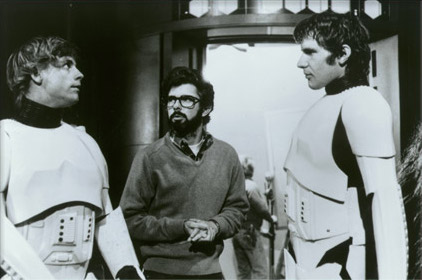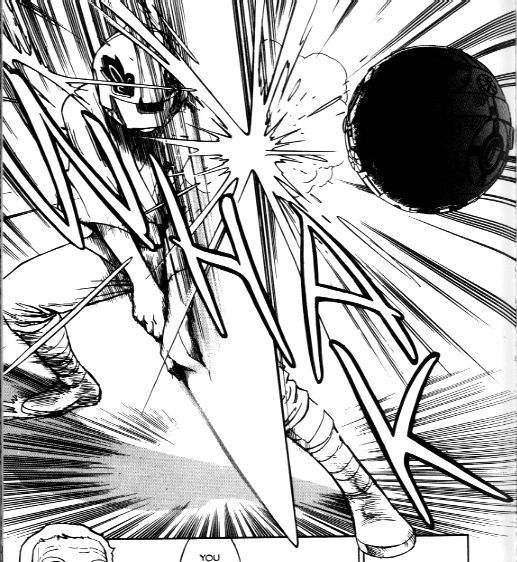As you may recall from Things 43, I’m a bit of a Star Wars fan.

So in terms of Things I found interesting in December, there was really only one. If you hate Star Wars I’ve got one other Thing for you below, a bit more music, and then it’s wall-to-wall Space Opera. I’ll save spoilery stuff until the very end and give fair warning.
Meine Schmusedecke / Patchwork Pals
At the Edinburgh Film Festival in 2010 (which I wrote about in this Things special), one of my favourite short animations was Lebensader by Angela Steffen. Last year at the DOK Leipzig film festival I was pleased to recognise her hand in a series of very short children’s animations about the adventures of some animals on a patchwork quilt.
There is an English dub, but I most enjoy the original German – I don’t know the language, but that’s what I like about it: the context and certain similar-sounding words make it a lot of fun to guess what’s going on. It’s about 3 minutes, and you should at least stick with it until the fox shows up:
Things Updates: Music and Dialogue
In Things November 2015 I quoted Dennett’s recommended method of dialogue, which involved carefully identifying areas of agreement, disagreement, and accurately re-stating your opponents position before attempting to debate it. Tarim wonders if this is inspired by “Buberian Dialogue” (pdf link):
The emergence technique proposed herein is sometimes called “Buberian dialogue.” The technique calls for two discussants, a moderator and an audience. The discussants each say their initial piece. It is the role of the audience to listen for what the two discussants have said or implied which might be in common. The audience is called upon to inform the discussants of these commonalities (which the moderator captures on a white board) and then for the discussion to turn to the revealed items. This occurs through three or more rounds. The aim is for a transformational experience. There is no effort to reach consensus or conclusion. Rather, the goal is for a transformation to take place in how the discussants view each other in the context of the debate. If a more human based respect emerges, the technique is successful.
Just imagine a political debate taking place through this form!
Tarim also adds his nominations for notable musical reworks (which began in Things with covers, reworking in general, and other examples from Things readers), while noting that unfortunately most of his favourite covers are those he heard live:
https://www.youtube.com/watch?v=cfvIMTlM4sY
(also)
Frank Zappa’s takes on Bolero and Stairway to Heaven:
And finally Far-Cue, a “3 piece punk band who do notable versions of: Mike Batt’s Remember You’re a Womble, Motorhead’s Ace of Spaces and Bach’s Toccata and Fugue.” Youtube videos exist, but “they just don’t capture the essence of Far-Cue” – which I can well imagine!
So what is this ‘Star Wars’ thing anyway

I grew up with Star Wars, and it’s now so much part of the cultural furniture that it’s quite hard to see what it really is.
Strip away what you already know, and think about how odd it is to launch a franchise with ‘Episode IV’. So odd that Fox didn’t allow it, and it was just ‘Star Wars’ until George was allowed to change it for the 1981 re-release (and of course he’s continued to change the films whenever he has the chance). This is just the most telling sign of what Lucas was trying to do: recreate the adventure-serial movies he enjoyed in his youth, in which you would usually be encountering a random episode and hearing talk about back-story you knew nothing about – “You fought in the Clone Wars?!” The other biggest clue is that he had first tried to get the rights to make a Flash Gordon movie, and being unable to get them, decided to just make his own thrilling space adventure instead. (As if annoyed how many people don’t realise this, Lucas mentions it repeatedly in all of the commentaries on the most recent DVD/Blu-ray release!)
The best modern analogue for what Lucas was doing is probably Robert Rodriguez’ Planet Terror, in which Rodriguez tries to make an exploitation B-movie as good as he always wished they were.
This is all very reasonable; the really weird part is how ridiculously successful it was. Here’s the US box office of the top 10 grossing movies in the 5 years running to 1977:

In 1975 Jaws was an outlier, a freakish break-out hit… and then Star Wars almost doubled Jaws’ US domestic takings. Worldwide, across all re-releases and adjusted for inflation, ‘Star Wars’ (aka Episode IV or A New Hope) is second only to Gone With the Wind, which came out in 1939, when 45% of the US population went to the cinema weekly, as opposed to 1977 when that figure was down to 10% (pdf source). Incredible.
I personally think three main factors helped Star Wars achieve this excessive success.
Generational Nostalgia
It seems for various reasons that people have their greatest ability to create influential cultural works between the ages of 30-40. That age group also commands a large amount of the money going to entertainment: those without children are at a peak ratio of earnings to needs, those with children will spend to entertain the whole family. This means entertainment that resonates with the 30-40 year-old generation can prove disproportionately popular, and nostalgia for their youth is a good approach. (When you enter this age group yourself, the first sign is that shops start playing the pop music of your youth).
Back to the Future went back from 1985 to 1955; Hairspray, The Wonder Years, Grease, Happy Days, and perhaps most nakedly That ‘70s Show all did a similar nostalgic leap. So in 1977 an audience existed that, like George Lucas, was nostalgic for the adventure serials.
This is also why we see favourite movies of the 80’s coming back 25-35 years later with sequels or remakes: Alien, Terminator, Robocop, Total Recall, Ghostbusters, Rocky, and Indiana Jones to name a few of the biggest.
Hairspray actually benefitted from the effect twice (set in 1962, made in 1988, remade in 2002). Star Wars has arguably benefitted three times: the initial adventure-serial throwback, and then the prequel trilogy and (just about) sequel trilogy each resonating with the generation that grew up with the previous Star Wars movies.
The Hero’s Journey
Aka the Monomyth, this is a story structure George Lucas studied and then consciously followed with Star Wars, and is one of the most popular story types that exist. Whatever else is going on, with this at the core you have a very strong narrative hook.
Execution
Episode IV’s script is weak: “This bucket of bolts is never going to get us past that blockade”, “Boy, it’s a good thing you have these compartments!” The pacing is also weird – at age 7 a friend and I were playing with our Star Wars toys when we realised we could watch the movie on VHS; after about 20 minutes we got bored and went back to the toys.

But apart from that (!), much of the execution is really incredible for the time. For one thing, Lucas founded a special effects company and a sound company that were each so successful they remain leaders in their fields even today. Relatedly, I suspect Ben Burtt’s sound design in particular elevated the film dramatically above other genre fare of the day (lightsabers, Vader’s breathing, blaster bolts, alien languages, background hum on ships… hundreds of convincing, world-building sounds in a single film).
How do you follow the most successful film in a generation?
Lucas found directing Star Wars incredibly stressful. With so much success, the world’s expectations would make directing a sequel even worse. I also suspect he knew a sequel would be held to a higher standard, and this adventure-serial schtick was going to wear thin. The one thing he had going for him was that the arc of the Hero’s Journey had plenty of life left. So he brought in a different director, got some pretty good script-writers, and took a back seat.
After seeing Star Wars films frequently throughout my life, it was only after a 5-year hiatus that I could re-watch them somewhat afresh as an adult, and realised that The Empire Strikes Back really is a step up in quality. Return of the Jedi then concluded the Hero’s Journey beautifully and assured Star Wars a long-lasting place in the minds of a generation.
In light of all the above, the seemingly weird prequels make a lot more sense. With financial security behind him, Lucas was able to get back to doing what he really wanted: adventure serial movies, complete with cheesy lines, melodrama and slightly wooden acting. I think the prequel trilogy is just the kind of movie Lucas wanted to make all along, and he actually got better at achieving that rather than worse.
I suspect the greatest problem for the prequels was that they’re not doing the ever-popular Hero’s Journey, but rather some sort of rise-and-fall tragedy, which the nuance-free adventure serial form is terrible at supporting.
The Force Awakens (no spoilers yet)
Which brings us to The Force Awakens. Back in 2005, after queuing for 16 hours, I got a ticket for the first 6-film Star Wars marathon and world premiere of Episode III: Revenge of the Sith at Leicester Square (showing the Original Trilogy and then the Prequel Trilogy, in order to save the newest addition until last).
At the end, George Lucas came over from the more star-studded premiere that had taken place in the nearby Odeon, and addressed the crowd. He was quickly drowned out by a chant that spontaneously arose from the fans: “We want nine! We want nine!”
Lucas calmed the crowd, and answered the request with these words I can still hear now:
“Star Wars is the story of Anakin Skywalker. It begins when he’s 9… it ends when he’s dead… there is no more story.”
(The BBC reporter recorded slightly different wording).
[Update – I rediscovered the recording I made of that intro! Perhaps unsurprisingly, the BBC reporter’s wording was closer than my memory – T.M. 16th April 2017]
As we now know, Disney thought there was at least $4bn more story, and they’re set on proving it, with new Star Wars episodes and spin-off films planned for every year from 2015 – 2020.
With all that history and no more Hero’s Journey story arc, how could Disney possibly satisfy the expectations of three generations of fans?
Well, that looks quite plausible. I particularly enjoyed the way a seemingly new and haunting piano progression evolves into a familiar theme – Han and Leia’s love theme in fact, which is a particularly apt choice following the end of Return of the Jedi.
At the time of writing, The Force Awakens has set the record for (unadjusted) US Domestic box office, and more impressively is at number 15 in the worldwide inflation-adjusted box office, putting it ahead of The Phantom Menace, Return of the Jedi, and just about on track to overtake The Empire Strikes Back, which would make it the most successful Star Wars film since 1977.
So that seems to be working.
I would say The Force Awakens has three major elements which could be ‘spoiled’, so is well worth trying to see with as little knowledge as possible. If you haven’t seen it yet, you should really do so before reading the rest.
Here’s a video to make it less tempting to read on:
The Force Awakens: True Successor or big-budget Fan Fiction? (SPOILERS!)
Over the first half an hour of the film I alternated between feeling that scenes, characters and designs were either not Star Wars enough, or just too much like old Star Wars. I finally realised I was holding the movie to an impossible standard, and substantially enjoyed the rest of it.
But by the end, it was undeniable: The Force Awakens looks a lot like a remake of 1977’s A New Hope. To try to make that assessment more fairly, I picked the most important 10 story elements from each and put them side-by-side:
| Episode IV: A New Hope | Episode VII: The Force Awakens |
| Opening arc of The Hero’s Journey | Opening arc of The Hero’s Journey |
| Scrappy underdogs vs. Fascist Military | Scrappy underdogs vs. Fascist Military |
| Destroy planet-scale superweapon | Destroy planet-scale superweapon |
| Death of the mentor | Death of the mentor |
| Protagonist triumphs through skill and faith | Protagonist triumphs through skill and faith |
| Males free female from captivity | Males free female from captivity (subverted) |
| MacGuffin in a droid: superweapon plans | MacGuffin in a droid: location of old hero |
| Escape from a death trap | Male frees male from captivity |
| Triumphant return of a protagonist | Bad guy turns good |
| Conclude with award ceremony | Conclude with ambiguous meeting with old hero |
So that’s 50% alike, 20% related, 30% new.
I can’t help wondering if this was actually the master plan: take the structure of the most successful of the series, add a scriptwriter of the most well-regarded, have the original cast pass the baton to the new, and laugh all the way to the bank. It seems to have worked.
In terms of style, I was very pleased to find it kept my favourite things from all of the Star Wars films: the adventure-serial (more mysterious back-story), family melodrama, and a script much more like Empire than any of the others (which makes sense, given Lawrence Kasdan’s involvement).
Let’s Get Nerdy (MORE SPOILERS)
Finally, as a Star Wars fan I can’t leave off without addressing some of the questions people tend to ask immediately after seeing the film.
How did Kylo Ren get beaten by amateurs?
The movie goes to extraordinary lengths to show Chewbacca’s bowcaster as some kind of devastating superweapon. Kylo Ren then gets shot with it, and the movie emphases his heavy bleeding and difficulty with the wound. Meanwhile it’s fair to assume Finn has some training in melee combat, and so is able to slightly injure Kylo’s sword-arm before being beaten. This means when Rey enters the fight, she’s fresh, and has been demonstrated capable in melee combat, while Kylo has two serious injuries!
How can Rey be so good with the Force so quickly?
I wondered this while watching the film, but it’s worth benchmarking. Anakin could drive pod-racers at inhuman speed at age 9, and demonstrated some sort of telepathy / far-seeing (in Yoda’s simple test) with no training. Luke deflects three blaster bolts while blindfold on his second try, uses the force to make a missile shot that was ‘impossible, even for a computer’, and later extracts a lightsaber from ice, again with no formal training.

By contrast, Rey does a Jedi mind trick on her third go, and beats Kylo Ren in a lightsaber summoning contest; in the latter case we again have his injuries to consider, and she was also pulling in the same direction as him.
Why did R2 take so long to wake up?
This requires some mumbo jumbo about R2 taking a while to process the information of BB-8 returning with the map piece and to come out of hibernation. The real reason is if he woke up immediately, it would create a difficult story-fork between fighting Starkiller Base and seeking out Luke.
Where are these planets relative to one another in the galaxy?
It’s unclear how Starkiller Base can really be “aimed” at another solar system, but apparently it can. We’re told it can somehow shoot through hyperspace, hence the ability to hit something light-years away. Dramatically less justifiable is that in a completely separate solar system, it’s possible to look in the sky and see the beam traverse and hit several planets in real time.
The only ‘explanation’ is that Star Wars is fantasy, not science fiction: planets are simply locations that are ‘far apart’, hence their uniform environment and the fact that everything that takes place on a planet seems to happen in one very small part of it. The worst offender in the original trilogy was arguably Empire, in which the Millennium Falcon apparently travels between two solar systems without a hyperdrive in a matter of weeks.
Who is Rey?
Child of Solo and Leia? Seems very weird they did not mention her when discussing their past troubles in The Force Awakens.
Grandchild of Kenobi? Seems very weird given that in Empire it is Kenobi’s ghost who says “That boy is our last hope” and Yoda who says “No… there is another”. Unless Yoda followed up with “Oh, and didn’t you also have a kid at some point, how are they getting on?”
Child of Skywalker? It seems insane he would abandon her with no training, and the whole bit with Kylo turning to the dark side and disrupting things comes much later.
In terms of trying to second-guess the series, I think it’s worth remembering that A New Hope set up Empire’s surprise-parentage twist by explicitly lying about it! As reliable old Ben told Luke, “A young Jedi named Darth Vader […] betrayed and murdered your father.”
So, and as usual: trust no one.
– Transmission finally ends